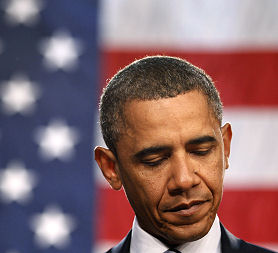US credit rating in danger of being downgraded
The US rating agency lowers its outlook on US sovereign debt to “negative” from “stable” after concerns Rebublicans and Democrats will not be able to agree on a plan to cut America’s deficit.
S&P maintained its “AAA/A-1+” credit rating on US sovereign debt, saying the nation’s “highly diversified” economy and “effective monetary policies” have helped support growth.
But the change in outlook to ‘negative’ means that there is one-in-three likelihood that S&P could lower the long-term credit rating on the United States within two years.
“More than two years after the beginning of the recent crisis, U.S. policymakers have still not agreed on how to reverse recent fiscal deterioration or address longer-term fiscal pressures,” S&P credit analyst Nikola G. Swann said.

The Obama administration said the negative outlook does not fully take in the country’s ability to face fiscal challenges. Treasury Department Assistant Secretary for Financial Markets Mary Miller said: “We believe S&P’s negative outlook underestimates the ability of America’s leaders to come together to address the difficult fiscal challenges facing the nation.”
The surprise move sent US stocks down by around 2 per cent, and affected markets across the world. In Europe, the main UK, German and French indexes all fell by at least 2 per cent.
The S&P 500 fell the most in a month, and the US dollar dropped against the euro and Swiss franc.
“The timing of S&P’s decision to revise the US ratings outlook from neutral to negative has come as a major surprise to the market, even if the deficit/debt backdrop that is driving this decision cannot be a surprise to any market professional with a pulse,” said Alan Ruskin, strategist at Deutsche Bank.
Since the US is the world’s largest economy, and its debt is considered the backbone of the world’s financial system, any concern over the US ability to pay its debt creates huge ripples in the world economy.
Congress battle
The move puts additional pressure on Congress to come up with a plan to bring down the deficit, which is currently projected be $1.6tn this year, bringing the cumulative public debt to $14.27 tn.
President Obama unveiled a proposal last week to cut $4 trillion from the deficits over 12 years by enacting a mix of spending cuts and tax increases
But he also suggested that the world could plunge into a new recession if the ceiling on money the US can borrow is not raised in the next few weeks, before the current debt limit of $14.3tn is reached.
Republicans – who control the House of Representatives- have proposed a competing plan to lower the long-term debt by $6.2 trillion over ten years, in part by shrinking Medicaid and Medicare. But that bill is not expected to make it through the Democrat-led Senate.
The S&P outlook cut comes after the International Monetary Fund (IMF) warned last week that the size of the US deficit created instability in the financial markets.
“If an agreement is not reached and meaningful implementation is not begun by then, this would in our view render the US fiscal profile meaningfully weaker than that of peer ‘AAA’ sovereigns.”
-
Latest news
-
Boy with profound learning disabilities reaches out of court settlement after abuse in residential school7m

-
India election: Modi rivals hit by string of raids and arrests7m

-
Can UK’s abandoned mines be used to build a greener future?5m

-
Sycamore Gap: Man pleads not guilty to felling iconic tree2m

-
‘Child poverty has not fallen since Tories came in’, says Gordon Brown5m

-




